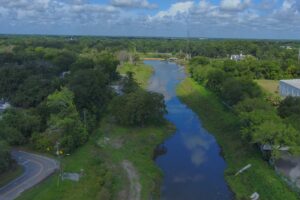Staff picks: We share our favorite district lands
Every so often we ask district staff: Where is your favorite place on district lands? Land Manager Graham Williams from the district’s Bureau of Land Resources, gives us his answer.

District Land Manager Graham Williams chose the district’s Hal Scott Regional Park and Preserve (seen here in a beautiful sunrise) as his favorite district property.
Hal Scott Regional Preserve and Park is a natural gem in urban central Florida
As the St. Johns River Water Management District’s south-central region land manager, I have the pleasure of getting to work on some amazing pieces of land in central Florida. People often ask me which one is my favorite. Each of our district properties is special to me in its own way, but the one that I connect with the most is Hal Scott Regional Preserve and Park in eastern Orange County.
Hal Scott Regional Preserve and Park protects approximately 9,000 acres of sensitive habitat, including some pristine pine flatwoods and about six miles of the Econlockhatchee River and its associated floodplain swamps and tributaries. The property is like an oasis in rapidly developing east Orlando. Despite its proximity to the hustle and bustle of the Orlando area, Hal Scott remains a true gem of a natural area with abundant wildlife, thanks to a long history of frequent fire management that has kept the natural communities in excellent condition.
Because the preserve and park are named for the late Hal Scott, former president and executive director of the Audubon Florida, it seems fitting that the property’s most famous residents are its woodpeckers. A population of the federally endangered red-cockaded woodpecker is found in the frequently burned flatwoods here. They’re well-adapted to fire and depend upon it to maintain the habitat in a suitable condition. Red-cockaded woodpeckers are the only woodpecker in our area that live exclusively in cavities drilled into pine trees. They require old-growth pines, especially longleaf pines, that have developed a heart-rot that helps to soften the inner wood of the tree. They can spend months or even years drilling through the hard outer wood of a mature longleaf pine to hollow out a cavity. They also drill resin wells around their cavities to cause sap to flow onto the face of the tree. This helps to discourage predators such as rat snakes from climbing up the tree trunk and into the cavity opening.
We closely monitor this bird’s population on our district property to ensure their success. We band each bird so we can easily identify every individual that we encounter in the field. This is usually accomplished when the birds are tiny chicks in the nest. We climb the trees and use a little noose made of fishing line to carefully retrieve the baby birds from the nest cavity. After a few quick measurements and notes each chick gets a set of colored bands gently placed onto its little legs in a process I’ve heard aptly described as being a bit like “putting a little ring on a piece of al dente pasta.” Then the baby woodpeckers are gently returned unharmed to their nest cavity.
Each red-cockaded woodpecker has a single cavity that it calls home. Sometimes it’s necessary to know which bird is living in which hole. Getting this information usually requires an alarm clock set way too early and a bit of patience. During the day, the birds are typically very active, moving widely about the forest in search of food. To determine “who’s living where” we do what’s called a roost check. This has become one of my favorite jobs. To be successful, we must be in place before the birds awaken and leave the safety of their cavity around sunrise. Then, we follow them and determine which birds they are based on the color combination of their leg bands. Each cavity tree has a unique tag as well, so we then know the tree that each individual bird calls. home.
I enjoy the brief time in the early dawn while I’m waiting patiently at a cavity tree for the woodpeckers to awaken. It is one of the quietest times in the forest when there is little noise but the occasional chirp of a cricket or the distant hoot of an owl. When it’s clear, the stars still in the morning sky make me forget that I’m just outside of Orlando.
Right before sunrise, it’s as if the entire forest returns to life around you as you await the sound of “seeeeeep” from a red-cockaded woodpecker. It is truly my favorite on-the-job experience. The dawn song and the awakening of the pine flatwoods at Hal Scott.





